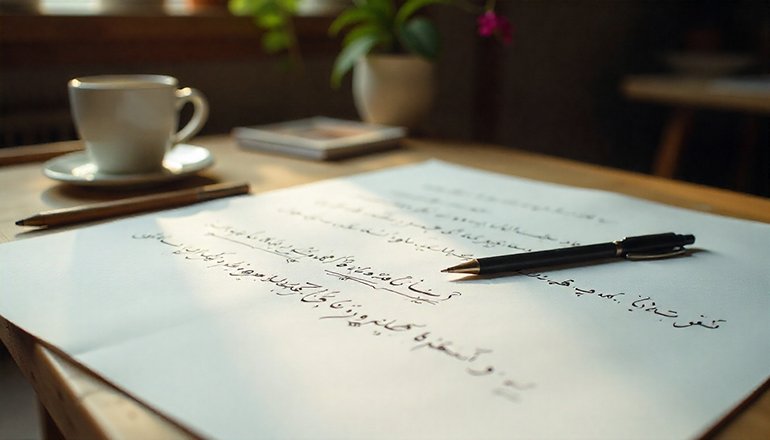
- comelyweb@gmail.com
- Online Printing Services
- September 4, 2025
- No Comments
Writing a Cover Letter in Urdu Guide
Table of Contents
ToggleWhy Urdu cover letter is more important than you think.
In the era of global English, you may wonder, “Is an Urdu cover letter even necessary?” The answer, more often than not, is a resounding yes. Here’s why:
- Cultural Affiliation and Respect: The use of Urdu shows deep respect for the local culture and language. This signals to the employer that you are not just applying to a company, but that you are specifically interested in being a part of it. Their The cultural and organizational fabric is extremely valuable for local businesses, government jobs, media houses, educational institutions and many private firms.
- Demonstrated communication skills: A well-written Urdu cover letter is a direct demonstration of your written communication skills in the language of the workplace. It proves that you can articulate complex professional ideas clearly and beautifully in Urdu, an important skill for many roles.
- Stand out from the crowd: While many may opt for a generic English template, a well-thought-out Urdu application makes you stand out instantly. It shows extra effort, attention to detail, and genuine desire for the position.
- Clarity and emotional resonance: Sometimes, you can express sincerity, humility, and passion more deeply in your native language. Urdu, with its rich vocabulary for honor and politeness, is exceptionally well-suited to establishing a genuine emotional connection.
Anatomy of a Perfect Urdu Cover Letter: Section by Section
Urdu cover letter follows the same logical structure as English but is influenced by cultural formalities. Let’s break it down.
1. Header/Letterhead
This is your professional identity at the top of the page. It should be neat and clean.
- Your full name: Your full name (eg Ayesha Rehman)
- Your address: Your full address
- Your contact information: Phone number and email address
- Date: Date (Write the date in Urdu: eg, 4 September 2024)
- Employer Details: Company name, hiring manager’s name (if known), their title, and company address.
2. Addressing
It is very important in Urdu culture which gives great importance to respect.
- If you know the name, Use a respectful title after the surname.
- Dear/Ms. [Name] Sir (Ms./Ms. [Name] Sahab) – This is the most common and respectful form. (eg Muthar Ahmad Sahib)
- If you don’t know the name Use a general but formal address.
- Dear Mr. Manager(Dear Manager) – Dear Sir, Manager.
- Dear Human Resource Manager (Please, Dear Human Resource Manager) – Please, Dear HR Manager.
- Avoid: Never use just the first name or an informal greeting such as “hi” (hi).
3. Subject line
Be specific and direct. This helps the letter reach the right person quickly.
- Example: “Application for the post of Senior Officer in Accounts Department” (Application for the post of Senior Officer in Accounts Department)
- Include employment reference number if any.
4. Introductory paragraph
Your goal here is to grab attention and get your point across immediately.
- Mention the position. You are applying and where you saw the advertisement (eg in the Daily War newspaper).
- Start with a strong opening line.
- Example: “Dear Sir, As per the advertisement published in your newspaper, I am willing to offer my services for the vacant post in the Accounts Department.” (Dear Sir, As per the advertisement published in your newspaper I want to offer my services for the vacancy in Accounts Department.)
5. Paragraph
This is the heart of your letter, usually 2-3 paragraphs where you sell your candidacy.
- Paragraph 1: Relate your skills to the job. Don’t just list what you’ve done. Explain how it prepares you. This particular character. Use the job description as a guide. Mention key accomplishments with metrics if possible (eg, “I led my team to increase business revenue by 15 percent”).
- Paragraph 2: Show that you know the company. Express your appreciation for the organization. Explain. why Do you want to work? This especially shows that you’ve done your research and aren’t just sending out mass applications.
- Paragraph 3: Highlight soft skills and cultural fit. Use the expressive nature of Urdu to convey your work ethic, passion, and team spirit. Words like hip (dedication)، Honesty, and Excellent performance are powerful.
6. Concluding paragraph
Be polite, reiterate your enthusiasm, and call for action.
- Thanks to readers for their time and consideration.
- Mention that you have attached your resume for more details.
- Express your desire for an interview.
- Example: “Given my qualifications and experience, I hope you will consider me. My CV is attached for your detailed information. I look forward to further clarifying my skills through an interview.”
7. Honorary Clause
Conclude with a formal and respectful ending.
- Sincerely yours (Yours sincerely)
- thank you (thank you)
- dignified (with respect)
Follow it with your handwritten signature (if sending a physical copy) and your typed full name.
Powerful tips and phrases to elevate your Urdu cover letter
Using the right words can make a significant difference.
- Instead of “I want”: use “I want to offer my services” (I want to offer my services) – more polite and professional.
- For “I’m an expert”: use “I’m good at [skill]” or “I’m an expert in [skill]”.
- For “I believe”: “I’m sure” or “I’m sure”.
- For “I’m looking forward to”: “I’ll wait”.
Common mistakes to avoid.
- Excessively flowery language: Although Urdu is beautiful, avoid excessive rhymes or archaic words that sound unnatural in a professional context. Clarity is key.
- Spelling and Grammar Errors: Nothing kills a professional image faster than typos. Proofread carefully. Use a spell checker or ask a native speaker to review it.
- Being too vague or general: Customize each character. The hiring manager can view the copied template immediately.
- Focus on what you want: Focus on what you focus on. can offer And how can you? Solve their problems..
- Incorrect length: Keep it short. One page is almost always enough.
A model for inspiration
Here’s a look at how body paragraphs can be structured:
“Dear Sir, I can relate to the qualities mentioned in your ad from my previous experience. I have experience designing and implementing marketing campaigns in my previous job, which resulted in a significant increase in recognition of our products on social media. I have always admired the quality and innovation of [company name], and I would be honored to be a part of your team in the development of your successful team and creativity.”
Frequently Asked Questions (FAQ)
Question 1: Should I always write my cover letter in Urdu?
A: Not always. It depends on the company and the job. If the job ad is in English, it may be an English-speaking environment. If the ad is in Urdu, or if it’s a local, government, or cultural organization, then Urdu is probably the best choice. When in doubt, you can’t go wrong with a well-written Urdu cover letter with an English resume that demonstrates versatility.
Q2: What if the company is multinational? Should I still use Urdu?
A: For multinational companies, it is often safer to use English unless you are sure that the local HR team prefers Urdu. You can research the company on LinkedIn to see what languages their local employees speak.
Q3: How formal should I be?
A: Urdu business culture is generally formal. It’s always better to err on the side of being too formal than too informal. Use respectful titles and avoid profanity or profanity.
Q4: Can I use the same Urdu cover letter for every job application?
A: Absolutely not. The most effective cover letters are tailored to each specific job and company. You should customize the body paragraph to reflect the requirements outlined in the job description and demonstrate why you are interested in this particular organization.
Q5: Is it acceptable to type a cover letter, or must it be handwritten?
A: In the digital age, a typed and printed (or PDF) letter is standard for almost all applications, whether emailed or uploaded to a portal. Handwritten letters are now very rare and are usually only requested for certain traditional or artistic roles.
Q6: Which font should I use to type in Urdu?
A: Use a clear, professional and widely compatible Nastaliq font. Common and good choices include. Jameel Noori memories. or Pak Nastaliq. Avoid fancy or hard-to-read fonts. Make sure the font size is readable (usually 12-14pt).
Conclusion: Your voice, your opportunity
Your cover letter in Urdu is more than just a formality. This is your story. This is the story you tell in the middle of your resume. In a competitive job market, it’s this personal, culturally aware narrative that can make a hiring manager stop, lean in, and decide you’re a candidate worth meeting with.
Embrace the beauty and precision of the Urdu language to craft a message that is both respectful and persuasive. Take the time to develop it, adapt it to your true passion, and refine it until it’s perfect. This document is your lawyer, your first impression, and the key to opening the door to your next great career opportunity.
So, open that document, and start writing your next chapter, not just an application. “Your Future Awaits” (Your future awaits).





